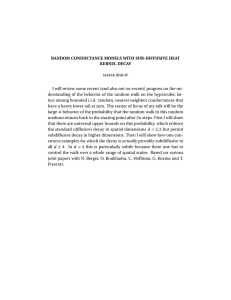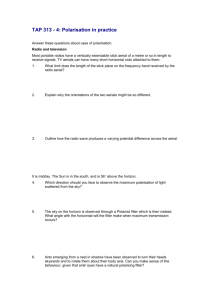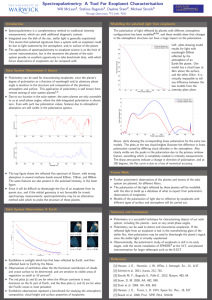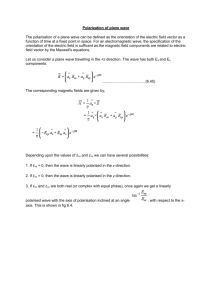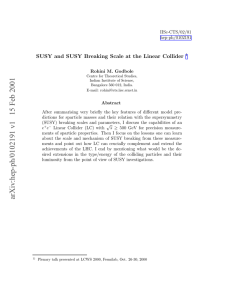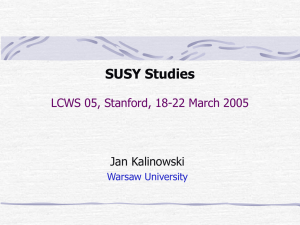Distinguishing SUSY scenarios using τ polarisation and Dark Matter. ˜ χ
advertisement
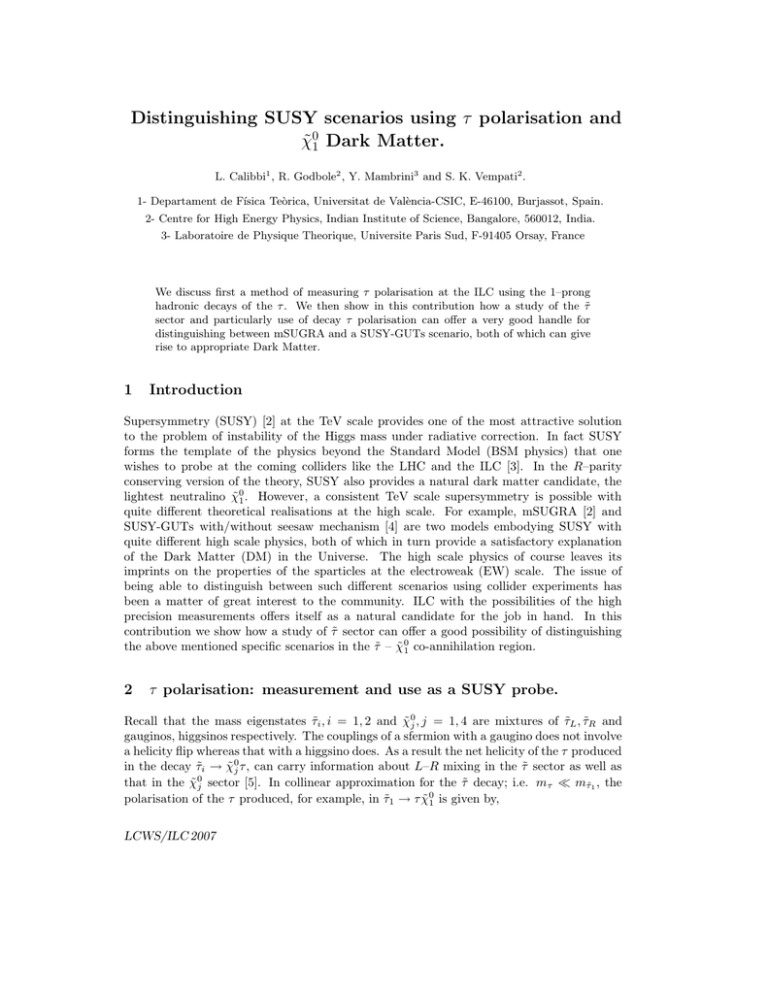
Distinguishing SUSY scenarios using τ polarisation and χ̃01 Dark Matter. L. Calibbi1 , R. Godbole2 , Y. Mambrini3 and S. K. Vempati2 . 1- Departament de Fı́sica Teòrica, Universitat de València-CSIC, E-46100, Burjassot, Spain. 2- Centre for High Energy Physics, Indian Institute of Science, Bangalore, 560012, India. 3- Laboratoire de Physique Theorique, Universite Paris Sud, F-91405 Orsay, France We discuss first a method of measuring τ polarisation at the ILC using the 1–prong hadronic decays of the τ . We then show in this contribution how a study of the τ̃ sector and particularly use of decay τ polarisation can offer a very good handle for distinguishing between mSUGRA and a SUSY-GUTs scenario, both of which can give rise to appropriate Dark Matter. 1 Introduction Supersymmetry (SUSY) [2] at the TeV scale provides one of the most attractive solution to the problem of instability of the Higgs mass under radiative correction. In fact SUSY forms the template of the physics beyond the Standard Model (BSM physics) that one wishes to probe at the coming colliders like the LHC and the ILC [3]. In the R–parity conserving version of the theory, SUSY also provides a natural dark matter candidate, the lightest neutralino χ̃01 . However, a consistent TeV scale supersymmetry is possible with quite different theoretical realisations at the high scale. For example, mSUGRA [2] and SUSY-GUTs with/without seesaw mechanism [4] are two models embodying SUSY with quite different high scale physics, both of which in turn provide a satisfactory explanation of the Dark Matter (DM) in the Universe. The high scale physics of course leaves its imprints on the properties of the sparticles at the electroweak (EW) scale. The issue of being able to distinguish between such different scenarios using collider experiments has been a matter of great interest to the community. ILC with the possibilities of the high precision measurements offers itself as a natural candidate for the job in hand. In this contribution we show how a study of τ̃ sector can offer a good possibility of distinguishing the above mentioned specific scenarios in the τ̃ – χ̃01 co-annihilation region. 2 τ polarisation: measurement and use as a SUSY probe. Recall that the mass eigenstates τ̃i , i = 1, 2 and χ̃0j , j = 1, 4 are mixtures of τ̃L , τ̃R and gauginos, higgsinos respectively. The couplings of a sfermion with a gaugino does not involve a helicity flip whereas that with a higgsino does. As a result the net helicity of the τ produced in the decay τ̃i → χ̃0j τ , can carry information about L–R mixing in the τ̃ sector as well as that in the χ̃0j sector [5]. In collinear approximation for the τ̃ decay; i.e. mτ mτ̃1 , the polarisation of the τ produced, for example, in τ̃1 → τ χ̃01 is given by, LCWS/ILC 2007 aR 11 2 aR 11 2 − aL 11 2 2 ; Pτ = aR 11 2g gmτ = − √ N11 tan θW sin θτ − √ N13 cos θτ , 2 2mW cos β aL 11 = + aL 11 gmτ g √ [N12 + N11 tan θW ] cos θτ − √ N13 sin θτ , 2 2mW cos β (1) where we have used the standard notation [2] with the matrix N representing the diagonalising matrix of the neutralino mass matrix with the notation χ̃1 = N11 B̃ + N12 W̃ + N13 H̃1 + N14 H̃2 . Pτ depends on the mixing in the slepton sector as well as that in the neutralino sector which are determined by the SUSY model parameters; thus giving a good handle of the measurement of SUSY parameters. Even more importantly, τ polarisation can be also measured well at the colliders. The energy distribution of the π produced in the decay, τ → ντ π as well as those in τ → ρντ , τ → a1 ντ depends on the handedness of the τ . In fact the angular distribution of the decay meson depends on τ polarisation and is different for longitudinal and transverse states of the vector meson v. The transverse (longitudinal) vector mesons share the energy of parent meson evenly (unevenly) among the decay pions. For the τ decay the only measurable momentum is τ -jet momentum and its value relative to pτ is determined by the meson decay angle. Hence the energy distribution of decay pions can be used then to measure the τ polarisation [6, 7, 8]. As a matter of fact a lot of nice analysis of τ polarisation and hence of the MSSM parameter determination at a Linear Collider, making use of the τ → ρ/a 1 ντ (multi-prong) mode exist [9, 10]. In this note we first discuss a method to determine the Pτ using 1–prong π final state [11]. If we consider the inclusive distributions of the 1–prong π final state and define R = pπ± /pτ −jet , one finds that for Pτ = 1 the distribution in R is peaked at R < 0.2 and R > 0.8, whereas for Pτ = −1 it is peaked in the middle. The observable R can be simply determined by measuring the energies of the τ in the tracker and the calorimeter. Further, the fraction σ(0.2 < R < 0.8) f= , σtotal can be shown to be very nicely correlated with the τ –polarisation [11] and hence can be used as its measure. Note that full reconstruction of the a1 and ρ as needed in the mutli-prong analysis is also not needed. The left panel in Fig.1 (taken from [11] shows distribution in √ R for different values of polarisations Pτ as indicated on the figure for specific choice of s, τ̃1 , χ̃01 masses and kinematical cuts on τ mentioned therein. The right panel shows f as a function of Pτ . Uncertainty due to the different parameterisations of the a1 and non-resonant contributions to the π, give rise to the slight spread of the lines. One can see from the Figure that ∆Pτ = ±0.03(±0.05) for Pτ = −1(+1). Even if an additional error were to come from the experimental measurement of f , still a measurement of Pτ with less than 10% error, i.e. ∆Pτ < 0.1 is sure to be possible. There is some dependence of the slope on the kinematics of the τ , but it is clear from the figure that the use of inclusive 1-prong channel, is a robust method of determining τ polarisation. If the aim is only to determine τ polarisation, then LCWS/ILC 2007 0.25 1 0.9 0.2 0.8 0.7 f dσ/dR 0.15 0.1 0.6 0.5 0.4 0.05 0.3 0.2 0 0 0.1 0.2 0.3 0.4 0.5 R 0.6 0.7 0.8 0.9 1 -1 -0.5 0 Pτ 0.5 1 Figure 1: Left panel shows R distribution for τ produced in τ̃1 → τ χ̃01 for different values of Pτ and right panel shows f , defined in text, as a measure of the polarisation. For details see [11] the 1–prong method has the advantage of higher statistics and smaller systematic errors, compared to the exclusive channel. 3 SUSY-GUTs, mSUGRA and τ polarisation Let us now see how the properties of the τ̃ sector and particularly the τ poalrisation can be used to distinguish between various SUSY models. In the present case, we will choose mSUGRA model and a SUSY SU (5) with seesaw mechanism (SU (5)RN ) [4]. Requiring neutralino DM relic density to be consistent with the recent WMAP measurements significantly reduces the degeneracies present in the parameter space between these two models. In fact, the effect is quite dramatic; in contrast to mSUGRA, the SUSY-GUT model has only two “allowed” regions: (a) the stau coannihilation channel, whose shape is quite different to the corresponding one in mSUGRAa ; (b) the A-pole funnel region which does exist for large value of tan β whereas a focus point region is not present at least up to 5 TeV in the SUSY masses [4]. From the above it’s clear that probing the τ̃ -neutralino sector could give a handle in distinguishing both the models as long as SUSY spectrum is determined by the coannihilation region, where the masses of τ̃1 and χ̃01 are very close. In fact, in our analysis [12], we find that the two models can be clearly distinguished from measuring Pτ in the decays of τ̃2 → τ χ̃01 (Fig. 2 right panel). Here for most of the parameter space, the Pτ has different signs. In the small overlap region, |∆Pτ | & 0.2, which make them distinguishable at the ILC. In the decay, τ̃1 → τ χ̃01 , the tau polarisation cannot be really used to distinguish between both the models as we see from the left panel of Fig. 2. In our analysis, we have assumed that τ̃1 and τ̃2 can be distinguished from the kinematics (as τ̃1 is closer to mass of χ̃01 in the coannihilation region). The behaviour of Pτ from τ̃2 → τ χ̃01 in the two frameworks can be understood as follows. In the approximation of χ̃01 ≈ B̃, very well satisfied in the τ̃ coannihilation region, Pτ just depends on the L–R mixing for τ̃ and is simply related to the parameters entering the τ̃ a And further predicts an upper bound on the χ̃01 mass for a given tanβ. LCWS/ILC 2007 Pτ Pτ ( τ1 −> χ1 ) tanβ = 40 0.5 0 −0.5 −0.5 100 200 300 400 500 mχ (GeV) −1 CMSSM tanβ = 40 0.5 0 −1 ( τ2 −> χ1 ) 1 1 100 200 300 400 SU(5)+RN 500 mχ (GeV) Figure 2: Left panel shows Pτ for mSUGRA and SU (5)RN model in τ̃1 → χ̃01 decay as a function of the χ̃01 mass. The blue(dark) points are for mSUGRA whereas the red(grey) points are for SU (5)RN model. The right panel shows the same for τ̃2 → χ̃01 . mass matrix [5]; given by: Pτ = 4m4LR − (m2LL − mτ̃21 )2 . 4m4LR + (m2LL − mτ̃21 )2 Here m2LL is the soft SUSY-breaking mass of τ̃L , mτ̃21 the lightest τ̃ mass eigenvalue and m2LR ' −mτ µ tan β the L–R mixing term. From this expression, we can see that the condition for a positive polarization reads: Pτ > 0 ⇔ 2 m2LR > m2LL − mτ̃21 (2) In mSUGRA, such condition can be satisfied for a small region of the paramater space. The factor 2 on the l.h.s. of Eq. 2 plays a crucial role. In SU (5)RN , the mixing term m2LR is enhanced as an effect of RH neutrinos and GUT [4], and this tends to make Pτ larger. Moreover there is an upper bound on the χ̃01 mass in the coannihilation region: these two effects conspire to keep Pτ always positive (right panel of Fig. 2). Thus in this contribution we show how, using τ polarisation and χ̃01 DM constraints, we can go a long way in distinguishing various SUSY models at the ILC. References [1] Slides: http://ilcagenda.linearcollider.org/contributionDisplay.py?contribId=343&sessionId=69&confId=1296 [2] See for example, M. Drees, R. Godbole and P. Roy, “Theory and phenomenology of sparticles: An account of four-dimensional N=1 supersymmetry in high energy physics,” Hackensack, USA: World Scientific (2004) 555 p [3] G. Weiglein et al. [LHC/LC Study Group], Phys. Rept. 426 (2006) 47 [arXiv:hep-ph/0410364]. [4] L. Calibbi, Y. Mambrini and S. K. Vempati, JHEP 0709 (2009) 081 [arXiv:0704.3518 [hep-ph]]. [5] M. M. Nojiri, Phys. Rev. D 51 (1995) 6281 [arXiv:hep-ph/9412374]. [6] K. Hagiwara, A. D. Martin and D. Zeppenfeld, Phys. Lett. B 235 (1990) 198. [7] D. P. Roy, Phys. Lett. B 277 (1992) 183. [8] B. K. Bullock, K. Hagiwara and A. D. Martin, Nucl. Phys. B 395 (1993) 499. [9] M. M. Nojiri, K. Fujii and T. Tsukamoto, Phys. Rev. D 54 (1996) 6756 [arXiv:hep-ph/9606370]. [10] E. Boos, H. U. Martyn, G. A. Moortgat-Pick, M. Sachwitz, A. Sherstnev and P. M. Zerwas, Eur. Phys. J. C 30 (2003) 395 [arXiv:hep-ph/0303110]. [11] R. M. Godbole, M. Guchait and D. P. Roy, Phys. Lett. B 618 (2005) 193 [arXiv:hep-ph/0411306]. [12] L. Calibbi, R. Godbole, Y. Mambrini and S. K. Vempati, to appear. LCWS/ILC 2007
